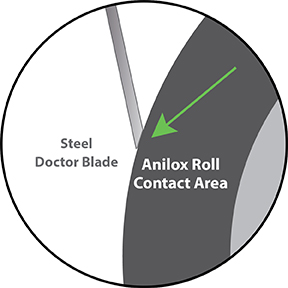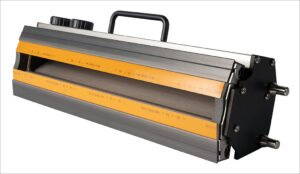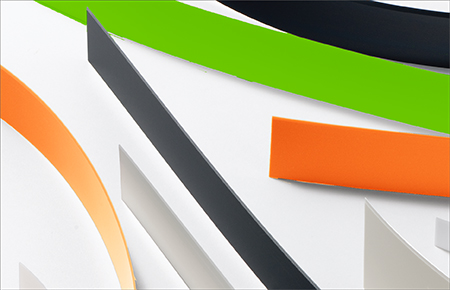 Market pressures continue to challenge the printing industry to deliver products that differentiate and delight. Doctor blade manufacturers have stepped up, introducing plastic blade technology that offers a viable alternative to steel and delivers a competitive edge. Here are some of the reasons that plastic doctor blade materials are way better than steel.
Market pressures continue to challenge the printing industry to deliver products that differentiate and delight. Doctor blade manufacturers have stepped up, introducing plastic blade technology that offers a viable alternative to steel and delivers a competitive edge. Here are some of the reasons that plastic doctor blade materials are way better than steel.
Safety
Steel blades cause a lot of pressroom injuries. Press operators put themselves at risk of being cut anytime they’re handling steel blades, but never more than when they are removing them from the press. The blades’ edges become honed as they wear, leaving razor-sharp tips.
By comparison, the properties of polymer materials prevent plastic blades from ever developing dangerous cutting edges. Even when worn, plastic blades are never sharp enough to injure press operators. Switching from steel to plastic blades will reduce lost-time accidents and save a printer a lot of money in workman’s compensation expenses, medical bills, labor replacement costs and press downtime.
 Performance
Performance
While safety is the hallmark of a plastic doctor blade, in the past, printers sometimes had to forego this benefit for the wiping capability of steel. Traditional plastic blades needed thickness to provide rigidity. They were unable to achieve a fine area of contact with the anilox roll in high-graphics applications, and steel blades were the only option.
But now, next-generation polymer materials and innovative tip technology can be combined to provide stiffness at thinner gauges. As a result, today’s plastic blades are able to maintain a fine contact area with the anilox roll and deliver metering performance on par with steel. The lower surface tension of polymers also facilitates an easier transfer of ink or coating to the plate. These properties enable plastic blades to resolve many press issues – such as UV spitting – that are commonly experienced with steel blades.
Durability
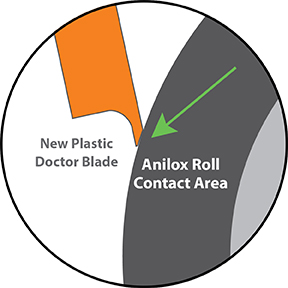 Plastic blades are durable and last longer than steel. The material is incredibly tough and stands up to abrasive chemistries like high titanium white inks and special effects coatings. The blade material is also self-lubricating with a low coefficient of friction to resist mechanical wear. Reducing the frequency of blade changes with plastic blades means presses can run longer without interruption.
Plastic blades are durable and last longer than steel. The material is incredibly tough and stands up to abrasive chemistries like high titanium white inks and special effects coatings. The blade material is also self-lubricating with a low coefficient of friction to resist mechanical wear. Reducing the frequency of blade changes with plastic blades means presses can run longer without interruption.
Cost-Effectiveness
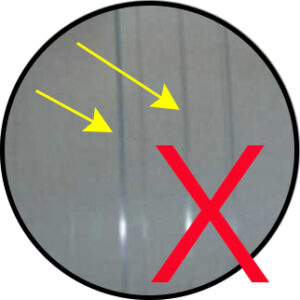 Plastic materials protect anilox rolls. Installing steel blades incorrectly or with too much pressure can cause fragments of metal to break away and destroy rows of anilox cells as the roll turns. Plus, the friction between a steel blade and anilox surface can erode cell walls. In either case, anilox damage leads to print defects, waste and significant costs to repair or replace the roll. Plastic blade materials, on the other hand, are non-abrasive. In the same way they will not cause injuries to operators, they will never damage rolls or cause premature anilox wear.
Plastic materials protect anilox rolls. Installing steel blades incorrectly or with too much pressure can cause fragments of metal to break away and destroy rows of anilox cells as the roll turns. Plus, the friction between a steel blade and anilox surface can erode cell walls. In either case, anilox damage leads to print defects, waste and significant costs to repair or replace the roll. Plastic blade materials, on the other hand, are non-abrasive. In the same way they will not cause injuries to operators, they will never damage rolls or cause premature anilox wear.
Sustainability
Last, but not least, using plastic doctor blades reduces a printer’s carbon footprint. Today’s next-generation polymer blade developers strive to create products that help their customers achieve their sustainability goals. Many new polymerizing methods use recaptured carbon monoxide (often from steel mills!), preventing the release of CO2 into the atmosphere. The process of producing plastic is much less energy-intensive than steel, emits less greenhouse gases, and has a smaller transportation component for raw materials and finished goods.
Early doctor blade chamber systems were designed for use with steel blades. But, to address the increasing demand for plastic doctor blades, chamber manufacturers, like TRESU, have introduced new blade holder systems that fit a range of blade thicknesses. With an interchangeable clamp apparatus, press operators have the flexibility to run plastic or steel or easily switch back and forth depending on their job requirements.
Printers looking for innovations to streamline their processes and keep pace with market demands are finding the solution in plastic doctor blades. Polymer blade materials provide durability and sustainability, and drive performance that exceeds steel – all while staying true to what made them great in the first place: safety. As the market continues to appreciate the benefits of plastic, industry suppliers will no doubt continue to develop products that help make them an option in every pressroom.
